How to deploy tomcat and Nginx on linux server
May 13, 2023 pm 06:58 PM1. Preparation
First you must have a linux server that can be played and know the username and password. Then you need to install two linux servers on your windows computer that can connect to it. The tools, xshell 5 and xftp 5, I won’t go into the installation tutorial. The supplementary picture shows how to connect to the server:
The xshell connection interface is as follows. After entering the host IP and click OK, xshell will pop up a window to enter the user name and password. The connection is successful!
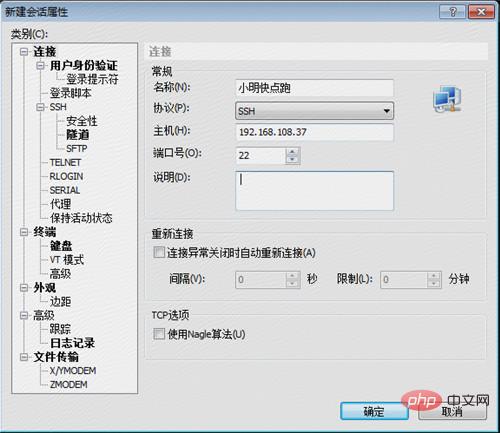
The xftp connection interface is as follows. Just fill in the blanks. It’s very simple. I won’t go into details. Let me mention why sftp is chosen instead of ftp here. See the difference between ftp and sftp. How much is enough to understand!
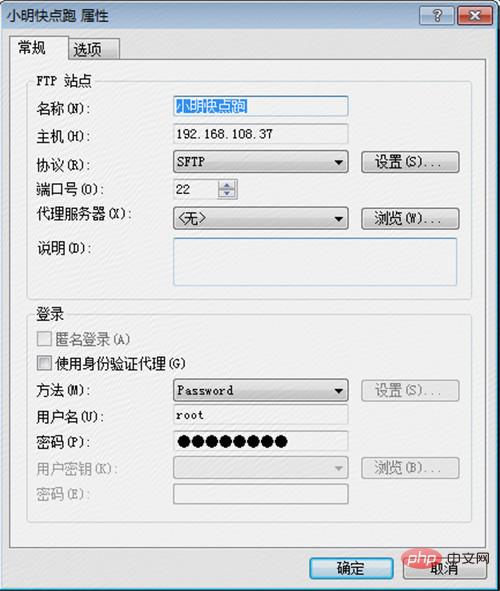
2. Installation and deployment work
If you want to deploy the project to a Linux server, it is essential to install jdk and tomcat Yes, what I want to emphasize here is that if you want to deploy multiple applications on one server, you need to have its own tomcat for each application, because the configuration of tomcat is definitely different for different applications. In this case, you can install a tomcat installation directory and tomcat working directories under multiple applications. For the same parts, you can share the tomcat installation directory. The following will introduce in detail how to operate and how to install tomcat and jdk to your On the server
1. Directory division
This is a very important step. You can create a new directory as shown in the figure below. Place the directory related to project startup and deployment under this directory. Accessing some related files, you can see that I have placed multiple versions of jdk and multiple versions of tomcat in this directory. Which tomcat and jdk to use during the project deployment process can be realized through configuration.
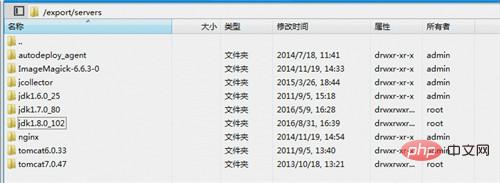
For actual applications, we put them in an instance directory, establish the name of each application, and then place the corresponding war package under the directory and unzip it. file, wait for tomcat to read the directory and deploy the application, as follows:


2. Modify the configuration
We also place the tomcat under each application under a directory for easy management, as shown below, but we must pay attention to the configuration of each tomcat


/bin directory, Both the start.sh file and the stop.sh file must be modified. First, you must specify the jdk path, which is similar to configuring environment variables. The second step is to specify the tomcat path of the tomcat working directory. You can notice that catalina_home and catalina_base correspond to the installation of tomcat respectively. Directory and working directory, and you can see from the last line that the project startup uses start.sh under the installation directory, but the tomcat configuration file used for project startup is the configuration file configured by each application tomcat. The same is true for stop.sh.

To use xshell to execute ./start.sh and ./stop.sh, permissions are required. If there is no permission, we can use xftp to email the start.sh To modify permissions, check the box as shown in the picture.
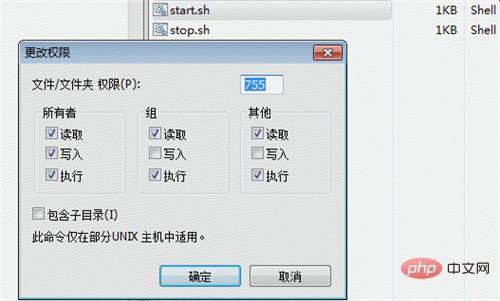
Under the /conf directory, you need to pay attention to the configuration modifications. The first is the server.xml file. Modify the corresponding port number. Each application of tomcat needs to modify different configurations. Port number, otherwise the port will be occupied when starting multiple tomcats and cannot be started. It is best to remember the port number of tomcat configured for this application, which will be used later when using nginx for port mapping;

Another place that needs to be modified is the root.xml file in the localhost directory under the catalina directory. This file is used to specify which directory to load the project instance when tomcat starts.

The other /logs directory, /temp directory, /webapps directory, and /work directory do not need to be modified; as can be seen from the above, the directory division is very clear, and they are divided into service installation directories (jdk, tomcat, nginx, etc.) ), application instance directory, and application deployment directory. You can also divide them in this way when using a Linux server to deploy multiple projects.
3.nginx implements port 80 reverse proxy
Logically speaking, at this time we can transfer the war package of our own application to the corresponding directory and decompress it , and then go to the corresponding application tomcat working directory and execute ./start.sh to start the project! You might as well give it a try first.
After the project is deployed, we configure the hosts and start accessing. At this time, we will find that we must add the tomcat port number configured above before we can access it. Can we not add the port number (using What about the default port 80)? As mentioned above, we have configured different port numbers for different tomcats. The reason is that one port number can only be used by one tomcat. This means that project access must add port numbers for access. However, it must be done for each It is also possible for an application to use port 80 for access. This is when nginx is used. After installing nginx, we can add some configurations to achieve reverse proxy, and forward access to port 80 used by different applications to The corresponding port number. From the perspective of tomcat, external requests still use the port number configured by tomcat, which achieves the effect we want. The specific configuration is as follows (of course we also have to do the corresponding directory division work):
The nginx directory is as follows:
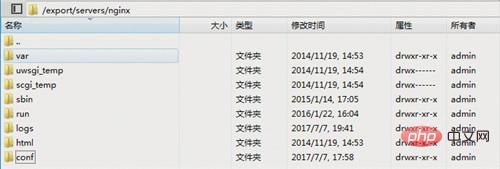
We only need to care about the nginx.conf configuration file under the /conf directory. I also opened the specific configuration information for everyone to see. Did you notice the last line, "include domains/*", which means that the configuration is not complete yet and includes all configuration files in the /domains directory,
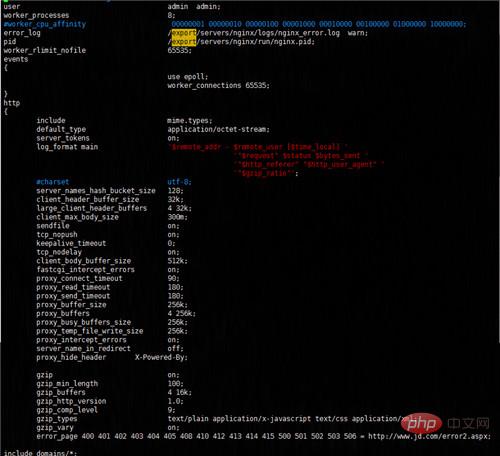
At this time we The corresponding nginx configuration for each application can be configured with differently named files

Then let’s take a look at how to configure it and listen to auction.center.jd.net :80 domain name access, and then forwarded to the 1605 port access of 127.0.0.1 of the local machine. From the configuration, we can also see that some abnormal states, such as http_500 http_502 http_504, etc., will be recorded and processed differently. Under normal circumstances You can jump to the homepage of the website, etc., and then record the log. After configuring this configuration file, we must not forget to create a new log directory, otherwise nginx cannot find the directory and will report an error when starting.

After completing these tasks, we are not finished yet. We need to restart nginx. I won’t go into details about how to restart. There is a lot of relevant information on Baidu. If the restart fails, we Just take a tough move, kill the nginx process, and then use the nginx service start command to start the nginx service.
After we have completed these tasks, can we use the familiar method (without adding a port number) to access it? Yes, that’s right. Many people are worried about whether it is still possible. To restart tomcat and redeploy the application, it only means that you do not understand the nginx routing conversion layer of the network layer. The domain name we visit first performs dns resolution through the hosts we configured, converts it to the corresponding ip, and finds the server corresponding to the ip. , through the server's firewall, and then when we configure nginx on the server, nginx will first intercept the request, process and distribute the request, and finally hit the corresponding tomcat (personal understanding, maybe the understanding is not in place, don't spray ), at this time we can access the domain name and send requests with confidence! !
4. Step into the trap
Um. . not good! ! I was overjoyed and jumped to the homepage, but still could not access the specified application. When I tried to add the port number, I was able to access it "miraculously". This means that the nginx we configured did not take effect. What is the problem? ?
Now let me talk about my problem-solving ideas. First, we have to confirm that all requests have gone to nginx. At this time, the benefits of logs are reflected. When we use port 80 to access our application, stare at the logs. Look, once, twice, three times. . There is no log. At this time, we can roughly conclude that the nginx service has not been used at all. We cannot be sure that the nginx service has not taken effect on the server. Maybe there is a problem with our log configuration. At this time, I made a bold operation. That is to turn off the nginx service access, or jump to the homepage of the website. What's going on? Isn't jumping to the homepage configured through nginx? Indeed, the company has already dealt with it at the network layer. At this time, I was very confused. It was just a matter of various attempts. I might as well modify the tomcat configuration and configure one of the applications to port 80, so that it can always be accessed. Soon, the modification was completed. After deploying it, I just waited for the domain name to be entered in the address bar to access it. Because the nginx service has been closed, the request at this time must be directly sent to tomcat. I accessed it once, twice and three times. Miraculously, I could not access it. Ni? ? ? At this time, I had a flash of inspiration. The server firewall must have disabled port 80. I quickly tried to telnet 192.168.108.37 80 locally and it turned out that I couldn't access it. This proved that my guess was correct. It was easy to handle now. I just needed to enable it in the firewall. Access to port 80 is sufficient. Below is a supplement on how to configure the iptables firewall to open port 80 under centos.
1. Open the iptables configuration file, the code is as follows: vi /etc/sysconfig/iptables
2. Use the /etc/init.d/iptables status command to check whether port 80 is open , if not, there are two ways to handle it
3. The first way: modify the vi /etc/sysconfig/iptables command to add the firewall to open port 80, the code is as follows:
Copy code Code As follows:
-a rh-firewall-1-input -m state --state new -m tcp -p tcp --dport 80 -j accept
4. Close/Open/Restart The firewall code is as follows: /etc/init.d/iptables stop (#start to open, #restart to restart)
5. The second method: add the port through the command, the code is as follows:
[root@centos httpd]# /sbin/iptables -i input -p tcp --dport 80 -j accept [root@centos httpd]# /etc/rc.d/init.d/iptables save [root@centos httpd]# /etc/init.d/iptables restart
6. Check the effect: [root@centos httpd]# /etc/init.d/iptables status
7. In addition, it is recommended to use the second method, which is simple to operate and has a high success rate. Take me For example, when I use the first method to modify the firewall configuration, the restart fails, but when I use the second method, it succeeds perfectly
The above is the detailed content of How to deploy tomcat and Nginx on linux server. For more information, please follow other related articles on the PHP Chinese website!

Hot AI Tools

Undress AI Tool
Undress images for free

Undresser.AI Undress
AI-powered app for creating realistic nude photos

AI Clothes Remover
Online AI tool for removing clothes from photos.

Clothoff.io
AI clothes remover

Video Face Swap
Swap faces in any video effortlessly with our completely free AI face swap tool!

Hot Article

Hot Tools

Notepad++7.3.1
Easy-to-use and free code editor

SublimeText3 Chinese version
Chinese version, very easy to use

Zend Studio 13.0.1
Powerful PHP integrated development environment

Dreamweaver CS6
Visual web development tools

SublimeText3 Mac version
God-level code editing software (SublimeText3)
 How to use PHP to develop a Q&A community platform Detailed explanation of PHP interactive community monetization model
Jul 23, 2025 pm 07:21 PM
How to use PHP to develop a Q&A community platform Detailed explanation of PHP interactive community monetization model
Jul 23, 2025 pm 07:21 PM
1. The first choice for the Laravel MySQL Vue/React combination in the PHP development question and answer community is the first choice for Laravel MySQL Vue/React combination, due to its maturity in the ecosystem and high development efficiency; 2. High performance requires dependence on cache (Redis), database optimization, CDN and asynchronous queues; 3. Security must be done with input filtering, CSRF protection, HTTPS, password encryption and permission control; 4. Money optional advertising, member subscription, rewards, commissions, knowledge payment and other models, the core is to match community tone and user needs.
 What is the code number of Bitcoin? What style of code is Bitcoin?
Jul 22, 2025 pm 09:51 PM
What is the code number of Bitcoin? What style of code is Bitcoin?
Jul 22, 2025 pm 09:51 PM
As a pioneer in the digital world, Bitcoin’s unique code name and underlying technology have always been the focus of people’s attention. Its standard code is BTC, also known as XBT on certain platforms that meet international standards. From a technical point of view, Bitcoin is not a single code style, but a huge and sophisticated open source software project. Its core code is mainly written in C and incorporates cryptography, distributed systems and economics principles, so that anyone can view, review and contribute its code.
 System requirements to install linux
Jul 20, 2025 am 03:49 AM
System requirements to install linux
Jul 20, 2025 am 03:49 AM
Linuxcanrunonmodesthardwarewithspecificminimumrequirements.A1GHzprocessor(x86orx86_64)isneeded,withadual-coreCPUrecommended.RAMshouldbeatleast512MBforcommand-lineuseor2GBfordesktopenvironments.Diskspacerequiresaminimumof5–10GB,though25GBisbetterforad
 How to build a PHP Nginx environment with MacOS to configure the combination of Nginx and PHP services
Jul 25, 2025 pm 08:24 PM
How to build a PHP Nginx environment with MacOS to configure the combination of Nginx and PHP services
Jul 25, 2025 pm 08:24 PM
The core role of Homebrew in the construction of Mac environment is to simplify software installation and management. 1. Homebrew automatically handles dependencies and encapsulates complex compilation and installation processes into simple commands; 2. Provides a unified software package ecosystem to ensure the standardization of software installation location and configuration; 3. Integrates service management functions, and can easily start and stop services through brewservices; 4. Convenient software upgrade and maintenance, and improves system security and functionality.
 How to use the `shutdown` command
Jul 15, 2025 am 12:26 AM
How to use the `shutdown` command
Jul 15, 2025 am 12:26 AM
The shutdown command of Linux/macOS can be shut down, restarted, and timed operations through parameters. 1. Turn off the machine immediately and use sudoshutdownnow or -h/-P parameters; 2. Use the time or specific time point for the shutdown, cancel the use of -c; 3. Use the -r parameters to restart, support timed restart; 4. Pay attention to the need for sudo permissions, be cautious in remote operation, and avoid data loss.
 How to make PHP container support automatic construction? Continuously integrated CI configuration method of PHP environment
Jul 25, 2025 pm 08:54 PM
How to make PHP container support automatic construction? Continuously integrated CI configuration method of PHP environment
Jul 25, 2025 pm 08:54 PM
To enable PHP containers to support automatic construction, the core lies in configuring the continuous integration (CI) process. 1. Use Dockerfile to define the PHP environment, including basic image, extension installation, dependency management and permission settings; 2. Configure CI/CD tools such as GitLabCI, and define the build, test and deployment stages through the .gitlab-ci.yml file to achieve automatic construction, testing and deployment; 3. Integrate test frameworks such as PHPUnit to ensure that tests are automatically run after code changes; 4. Use automated deployment strategies such as Kubernetes to define deployment configuration through the deployment.yaml file; 5. Optimize Dockerfile and adopt multi-stage construction
 How to get help for a command in Linux?
Jul 17, 2025 am 12:55 AM
How to get help for a command in Linux?
Jul 17, 2025 am 12:55 AM
There are four ways to obtain command help in Linux: First, use --help to view basic usage, which is suitable for quickly understanding common options and parameters of commands; second, use man to view the complete man page, providing detailed command descriptions and examples; third, use info to view structured help, which is suitable for information navigation of complex commands such as gcc and make; fourth, refer to network resources and communities, such as Linux China, StackOverflow and other platforms to obtain Chinese materials or solve specific problems. It is recommended for beginners to master it step by step from --help and man.
 How to build an independent PHP task container environment. How to configure the container for running PHP timed scripts
Jul 25, 2025 pm 07:27 PM
How to build an independent PHP task container environment. How to configure the container for running PHP timed scripts
Jul 25, 2025 pm 07:27 PM
Building an independent PHP task container environment can be implemented through Docker. The specific steps are as follows: 1. Install Docker and DockerCompose as the basis; 2. Create an independent directory to store Dockerfile and crontab files; 3. Write Dockerfile to define the PHPCLI environment and install cron and necessary extensions; 4. Write a crontab file to define timing tasks; 5. Write a docker-compose.yml mount script directory and configure environment variables; 6. Start the container and verify the log. Compared with performing timing tasks in web containers, independent containers have the advantages of resource isolation, pure environment, strong stability, and easy expansion. To ensure logging and error capture






